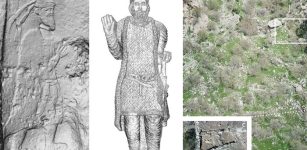Hill Of 100,000 Crosses In Lithuania Survived Against All Odds
Ellen Lloyd - AncientPages.com - For many centuries, people in Lithuania have put up crosses on a hill located about sixteen kilometers from Šiauliai, a city in the North.
Over the years, many attempts were made to end this practice, but people never gave up and continued to place crosses on the hill. Today the place is known as the Hill of Crosses and it has become a symbol not only of faith, but also a reminder of resistance against oppression.
The hill is 60 meters long and 40-50 meters wide and it is believed the first cross was placed here by the relatives of the victims of the Lithuanian rebellion in 1831.
Symbol Against Oppression
The Russian Tsar, Nicholas I and his government prohibited any kind of freedom and Russia was a typical police state with a wide net of spies and harsh punishments for any thought or action against the government. Countries like Lithuania and Poland, which had been subjugated by Russia made several revolts against the despotic regime.
People desired liberty, freedom, and independence, but the despotic atmosphere weighed on all Russia, and even more so on the subjugated countries.
In 1831, the tsarists government did not allow the families to honor their dead properly and people started to place crosses on the hill. After the second rebellion in 1863, there were even more crosses.
The crosses were first counted in 1900 and at the time there were 130 crosses on the hill. The number of crosses continued to rise, and the place took on a special significance during the years 1944–1990, when Lithuania was occupied by the Soviet Union.
See also:
10 Types Of Ancient Crosses In Different Cultures Explained
The Name Vatican And Etruscan Goddess Vatika Of The Underworld – What Is The Connection?
Lost Q Source Remains An Unsolved Biblical Mystery
Mystery Of The Lost Biblical City Of Ai – Where Was It Located?
In 1961, the Soviet government demolished over 5000 crosses, by 1975 – 1200 crosses more. The Soviet government considered the crosses and the hill a hostile and harmful symbol.
People in Lithuania did not give up. They continued to go to the Hill of Crosses, and leave their tributes, Lithuanians used it to demonstrate their allegiance to their original identity, religion and heritage. The Soviet government tried to destroy this sacred site on at least three occasions.
Hill Of Crosses Is A Sacred Site
There were even rumors that the authorities planned to build a dam on the nearby Kulvė River, so that the hill would end up underwater.
On September 7, 1993, Pope John Paul II visited the Hill of Crosses, declaring it a place for hope, peace, love and sacrifice. In 2000, a Franciscan hermitage was opened nearby.
Today the Hill of Crosses is visited by many people from different countries. Catholic pilgrims are placing here not only crosses, but also but statues of the Virgin Mary, carvings of Lithuanian patriots and thousands of tiny effigies and rosaries.
The number of crosses in 2006 was 100,000.
The crosses on the Hill of Crosses are also endless reminders of peoples’ misfortunes, sorrow and catastrophes. On September 28, 1994, MS Estonia was sailing from Estonia to Sweden. The weather was bad and the ferry sent a distress signal. Water flooded in through an open bay door. The ferry sank within five minutes. The total number of dead was 852 and some of them were rather poor people who had finally saves money and could make their first journey to Sweden.
After the MS Estonia catastrophe, one cross was put on the Hill of Crosses.
The cross is best known as a Christian symbol but this ancient universal symbol has its beginnings in the most remote times and there are several different types of crosses used by many ancient cultures.
Written by Ellen Lloyd – AncientPages.com
Copyright © AncientPages.com & Ellen Lloyd All rights reserved. This material may not be published, broadcast, rewritten or redistributed in whole or part without the express written permission of AncientPages.com and Ellen Lloyd
About the author:
Ellen Lloyd – is the owner of AncientPages.com and an author who has spent decades researching ancient mysteries, myths, legends and sacred texts, but she is also very interested in astronomy, astrobiology and science in general
More From Ancient Pages
-
 Mysterious 2,000-Year-Old Lost City Of Natounia May Have Been Found!
Archaeology | Jul 20, 2022
Mysterious 2,000-Year-Old Lost City Of Natounia May Have Been Found!
Archaeology | Jul 20, 2022 -
 Mystery Of The Ancient Unknown Mining Civilization In North America – Connecting the Dots – Part 2
Ancient Mysteries | Apr 23, 2022
Mystery Of The Ancient Unknown Mining Civilization In North America – Connecting the Dots – Part 2
Ancient Mysteries | Apr 23, 2022 -
 Susanoo-no-Mikoto – Shinto God Of The Sea And Storms Was Banished From Heaven
Featured Stories | Nov 23, 2018
Susanoo-no-Mikoto – Shinto God Of The Sea And Storms Was Banished From Heaven
Featured Stories | Nov 23, 2018 -
 A Stone Age Child Buried With Bird Feathers, Plant Fibers And Fur Investigated In Finland
Archaeology | Nov 2, 2022
A Stone Age Child Buried With Bird Feathers, Plant Fibers And Fur Investigated In Finland
Archaeology | Nov 2, 2022 -
 Ostrich Egg Vessel And Thracian Horseman Fibula Found In Roman-Era Burial Mound In Bulgaria
Archaeology | May 5, 2020
Ostrich Egg Vessel And Thracian Horseman Fibula Found In Roman-Era Burial Mound In Bulgaria
Archaeology | May 5, 2020 -
 Gil Pérez: Unexplained Ancient Teleportation Of A Spanish Soldier
Featured Stories | Oct 15, 2018
Gil Pérez: Unexplained Ancient Teleportation Of A Spanish Soldier
Featured Stories | Oct 15, 2018 -
 Unique Tomb Of Roman Noblewoman Caecilia Metella Reveals Secrets Of Ancient Concrete Resilience
Archaeology | Oct 14, 2021
Unique Tomb Of Roman Noblewoman Caecilia Metella Reveals Secrets Of Ancient Concrete Resilience
Archaeology | Oct 14, 2021 -
 Unexplained Ancient Wars In America – Knowledge Of Ancient High-Tech Weapons? – Part 1
Ancient Mysteries | Sep 29, 2020
Unexplained Ancient Wars In America – Knowledge Of Ancient High-Tech Weapons? – Part 1
Ancient Mysteries | Sep 29, 2020 -
 Mystery Of Count St. Germain – He Claimed To Have Lived For Several Centuries
Ancient Mysteries | Sep 4, 2014
Mystery Of Count St. Germain – He Claimed To Have Lived For Several Centuries
Ancient Mysteries | Sep 4, 2014 -
 Mystery Of The Coal On The Pirate Shipwreck Queen Anne’s Revenge Solved
Archaeology | Apr 13, 2023
Mystery Of The Coal On The Pirate Shipwreck Queen Anne’s Revenge Solved
Archaeology | Apr 13, 2023 -
 Brown Hares And Chickens Were Seen As Gods Not Food In Iron Age Britain
Archaeology | Apr 12, 2020
Brown Hares And Chickens Were Seen As Gods Not Food In Iron Age Britain
Archaeology | Apr 12, 2020 -
 Abduction Of Idun, Goddess-Keeper Of Golden Juvenile Apples In Norse Mythology
Featured Stories | Nov 16, 2019
Abduction Of Idun, Goddess-Keeper Of Golden Juvenile Apples In Norse Mythology
Featured Stories | Nov 16, 2019 -
 Is The Legendary Tsuchinoko Real?
Featured Stories | Aug 21, 2019
Is The Legendary Tsuchinoko Real?
Featured Stories | Aug 21, 2019 -
 Apollo – Loved And Feared Greek God Of Divination And Prophecy Who Was Also Seer Of Zeus
Featured Stories | Feb 6, 2019
Apollo – Loved And Feared Greek God Of Divination And Prophecy Who Was Also Seer Of Zeus
Featured Stories | Feb 6, 2019 -
 Temple Of Lord Vishnu Dated To Hindu Shahi Dynasty Unearthed In Pakistan
Archaeology | Nov 22, 2020
Temple Of Lord Vishnu Dated To Hindu Shahi Dynasty Unearthed In Pakistan
Archaeology | Nov 22, 2020 -
 Does The Shigir Idol Depict Demons And Evil Spirits?
Archaeology | May 3, 2018
Does The Shigir Idol Depict Demons And Evil Spirits?
Archaeology | May 3, 2018 -
 Funerary Urn Depicting The God Of Corn Unearthed In Mexico By INAH Archaeologists
Archaeology | Jan 11, 2024
Funerary Urn Depicting The God Of Corn Unearthed In Mexico By INAH Archaeologists
Archaeology | Jan 11, 2024 -
 Norse Legend Of Hero Sigmund And The Magical Sword In The Branstock Tree
Featured Stories | Jul 8, 2025
Norse Legend Of Hero Sigmund And The Magical Sword In The Branstock Tree
Featured Stories | Jul 8, 2025 -
 Beautiful Gold ‘Lynx’ Earrings Discovered In The Ruins Of The Ancient Lost City Of Ani Go On Display In 2023
Archaeology | Dec 29, 2022
Beautiful Gold ‘Lynx’ Earrings Discovered In The Ruins Of The Ancient Lost City Of Ani Go On Display In 2023
Archaeology | Dec 29, 2022 -
 Ancient Roman Statues of Goddess Venus And Other Precious Artifacts Found In A Trash Pit In France
Archaeology | Apr 8, 2023
Ancient Roman Statues of Goddess Venus And Other Precious Artifacts Found In A Trash Pit In France
Archaeology | Apr 8, 2023




